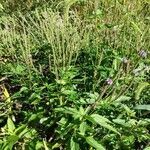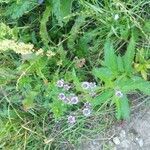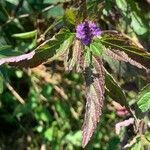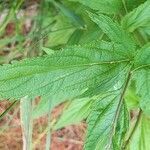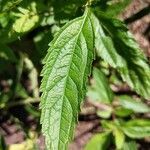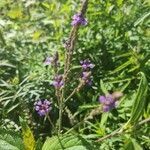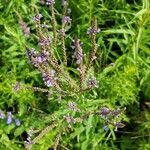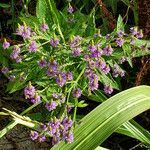Perennial; stems 4–15 dm, branched above, rough-hairy, with short, spreading or antrorse hairs; lvs lanceolate to lance-oblong or lance-ovate, 4–18 cm, gradually acuminate, petiolate, coarsely serrate or incised, often hastately 3-lobed at base, glabrous or strigillose on both sides; spikes strict, usually many in a terminal panicle, short and compact, thicker than in no. 5 [Verbena urticifolia L.]; bracts lance-subulate, commonly a little shorter than the cal; cal 2.5–3 mm, hairy, with ± connivent, shortly subulate-tipped lobes; cor usually blue, the tube somewhat longer than the cal, hairy, the limb 2.5–4.5 mm wide; nutlets linear, 1.5–2 mm, faintly striate or smooth; 2n=14. Moist fields, meadows, prairies, and swamps; N.S. to B.C., s. to Fla. and Ariz. June– Oct. A hybrid with V. simplex is V. ×blanchardii Moldenke; one with V. stricta is V. ×rydbergii Moldenke.
More
A small shrub. It grows 0.9-1.5 m high and spreads 30-60 cm wide. It keeps growing from year to year. The stems are stiff and upright. The leaves are lance shaped and have teeth along the edge. The leaves are rough. The flowers are small and violet-blue. They are in spiky clusters.
Swales, damp thickets and shores. Moist meadows, thickets, and pastures, as well as riversides, marshes, ditches, and river-bottom prairies.
More
It is a temperate plant. It grows in damp locations and along roadsides and in wet fields. It suits hardiness zones 3-9.
